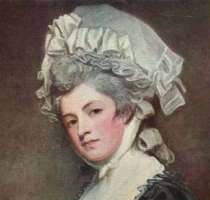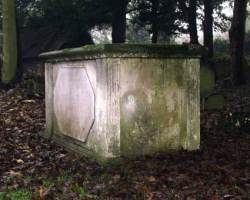


| [ Previous ] [ Next ] |

|
"Yesterday, a messenger arrived in town, with the very interesting and pleasing intelligence of the Tarleton, armed ship, having, after a chace of some months, captured the Perdita frigate, and brought her safe into Egham port. The Perdita is the prodigious fine clean bottomed vessel, and had taken many prizes during her cruise, particularly the Florizel, a most valuable ship belonging to the Crown, but which was immediately released, after taking out the cargo. The Perdita was captured some time ago by the Fox, but was, afterwards, retaken by the Malden, and had a sumptuous suit of new rigging, when she fell in with the Tarleton. Her manoeuvering to escape was admirable; but the Tarleton, fully determined to take her, or perish, would not give up the chace; and at length, coming alongside the Perdita, fully determined to board her, sword in hand, she instantly surrendered at discretion."
 [more information] |
In September, 1782, London's Morning Post used this nautical allegory to satirize the newly established relationship between Banastre Tarleton and actress Mary Darby Robinson. The newspaper didn't miss the opportunity to enumerate Mary's "fleet" of earlier admirers: Lord Malden, Charles James Fox, and "Florizel", better known as H.R.H. George, Prince of Wales.
Mary Robinson was destined in her brief life to become an actress, a poet, a novelist and one of the most famous courtesans of Georgian London. Her relationship with Tarleton lasted for fifteen years, finally terminating only a few months before he met his future wife, Susan Priscilla Bertie. Although they didn't marry, their association seems to have been closer to a modern common-law partnership than the standard protector/mistress paradigm of the period.
After two centuries of obscurity, Robinson has begun to re-enter the limelight with a vengeance, drawing interest from literary historians and, in particular, from those interested in 18th century feminism. The growing consensus seems to be that all of her published biographies -- including her own memoirs -- are untrustworthy. Rather than try to sort through a host of conflicting current theories to update the longer bio note I had posted for her previously, I'm going to take the lazy woman's approach and simply provide some sources and links which the reader may explore at leisure.
 [more information] |
To go along with the photos of her grave which Peter Tarleton has kindly provided, here are two contemporary obituaries, and a brief satirical article she wrote, which was published posthumously in Scots Magazine.
As one of the celebrated beauties of her day, Mary was painted a number of times. In addition to the Romney portrait (see thumbnail above), she left behind a portrait by Gainsborough, and several images by Reynolds, including the painting he was working on at the same time he painted Tarleton, and an unusual profile done after illness had invalided her. She was also painted by George Dance, Zoffany, Richard Cosway and probably others.
The popular press generated numerous less flattering images, in the form of political cartoons, mostly dating from her back-to-back affairs with the Prince of Wales and Charles James Fox.
In my "Banecdotes" section, there is also a brief article on how her relationship with Tarleton was reflected in her poetry and prose.
At least three novels have focused on Mary: Perdita's Prince by Jean Plaidy (1969), and Exquisite Perdita by E. Barrington (New York, Dodd, Mead & Co., 1926), both recount her affair with the Prince of Wales.
Stanley J. Makower's Perdita, a Romance in Biography (1908) is a more general pseudo-biography, covering her entire life.
She also wrote what may be interpreted as a pseudo-autobiography in her final novel, The Natural Daughter. This has just been re-issued, packaged with the feminist treatise she wrote near the end of her life, by a literary press.
As proof of Mary's return to the limelight, 2004 saw the publication of two new biographies, with a third one following early in 2005. The first two both make interesting reading; the third I would not particularly recommend. They are:
Other sources include:
| [ Index ] | [ Previous ] [ Next ] |
1 In her memoirs, Mary claims that "on the 27th of November, 1758, I first opened my eyes to this world of duplicity and sorrow," but a recent article says her true birth date, according to the registry of St. Augustine's in Bristol, was 27 November 1756. See Alex Nathan, "Mistaken or Misled? Mary Robinson's Birth Date," Women's Writing, 9 (2002): 139-142. [ back ]
| Return to the Main Page | Last updated by the Webmaster on October 3, 2006 |